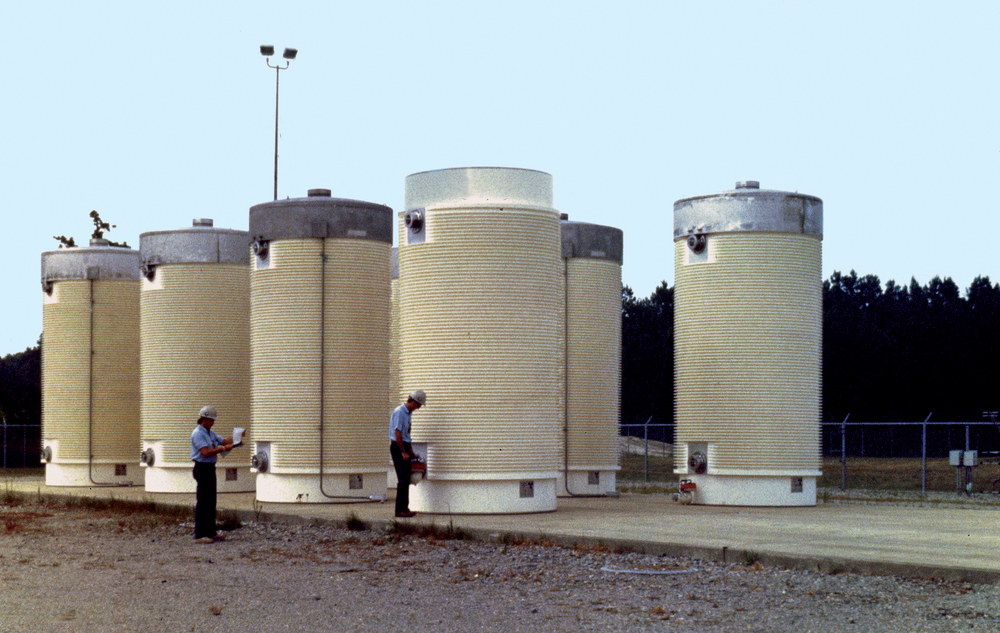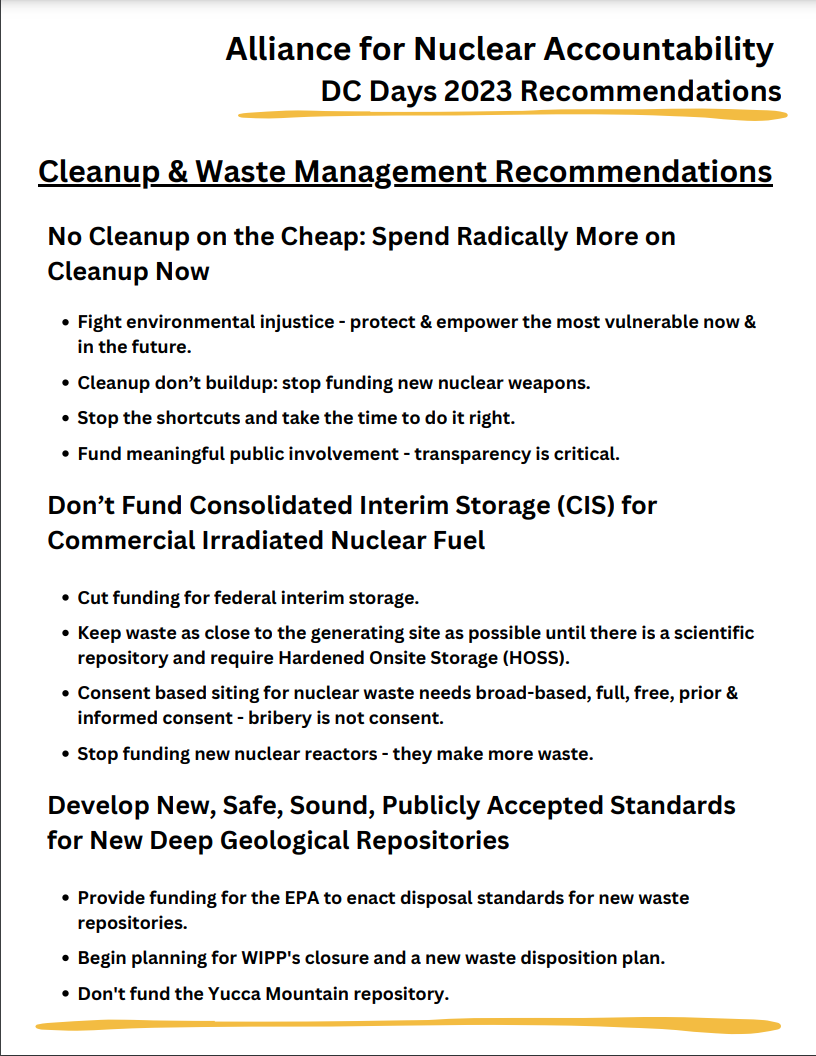Background on Nuclear Waste Issues
Nuclear Waste storage is a multi-generational challenge
 The waste that comes as a byproduct of our nuclear weapons complex and nuclear reactors will impact thousands of generations. We have no storage and disposition plan that can tackle a problem of that scope so we currently look at methods that will allow us to mitigate the risks and costs associated with this growing challenge. The need for consent by those affected becomes essential to avoid the dumping of this hazardous waste on populations that are disempowered. In addition, we urgently need an interim waste management plan that will allow the Federal Government the time it needs to consider a more enduring solution.
The waste that comes as a byproduct of our nuclear weapons complex and nuclear reactors will impact thousands of generations. We have no storage and disposition plan that can tackle a problem of that scope so we currently look at methods that will allow us to mitigate the risks and costs associated with this growing challenge. The need for consent by those affected becomes essential to avoid the dumping of this hazardous waste on populations that are disempowered. In addition, we urgently need an interim waste management plan that will allow the Federal Government the time it needs to consider a more enduring solution.
Yucca Mountain poses risks beyond Nevada communities
 When Nevada lacked clout in Congress, a plan was made for the nation’s nuclear waste to be shipped to a proposed centralized storage site in Yucca Mountain. Beyond geological concerns with the plan, local communities in Nevada near Yucca Mountain have protested the decision to move this waste into their backyard. Yucca Mountain also poses risks beyond Nevada communities. Because of its distance from the vast majority of nuclear waste in the country (which is mostly east of the Mississippi), the transportation routes for this hazardous material would impact a wide swath of the United States. While rail accidents are rare, low probability events occur over time and the risk posed from the transport of this material should concern many Americans.
When Nevada lacked clout in Congress, a plan was made for the nation’s nuclear waste to be shipped to a proposed centralized storage site in Yucca Mountain. Beyond geological concerns with the plan, local communities in Nevada near Yucca Mountain have protested the decision to move this waste into their backyard. Yucca Mountain also poses risks beyond Nevada communities. Because of its distance from the vast majority of nuclear waste in the country (which is mostly east of the Mississippi), the transportation routes for this hazardous material would impact a wide swath of the United States. While rail accidents are rare, low probability events occur over time and the risk posed from the transport of this material should concern many Americans.
Hardened Dry Cask Storage offers an interim solution
While the debate over waste management continues, nuclear waste is currently being stockpiled at a number of different sites and on-site at nuclear reactors. Left is an image of dry casks that, if hardened from attack, could offer a realistic interim solution that limits the movement of this hazardous material. While this will not eliminate the risk associated with nuclear waste, hardened on-site storage (HOSS) represents a practical solution that can be implemented far quicker and with less far-reaching problems as any proposed centralized waste facility would engender.
Reprocessing is not a responsible waste management plan
 Reprocessing refers to the chemical separation of fissionable uranium and plutonium from irradiated nuclear fuel. The International Framework for Nuclear Energy Cooperation (IFNEC), formerly the Global Nuclear Energy Partnership (GNEP), aims to accelerate the development and deployment of advanced nuclear fuel cycle technologies while providing greater disincentives to the proliferation of nuclear weapons. GNEP was initiated by the USA early in 2006, but picked up on concerns and proposals from the International Atomic Energy Agency (IAEA) and Russia. The vision was for a global network of nuclear fuel cycle facilities all under IAEA control or at least supervision. (Source: World Nuclear Association)
Reprocessing refers to the chemical separation of fissionable uranium and plutonium from irradiated nuclear fuel. The International Framework for Nuclear Energy Cooperation (IFNEC), formerly the Global Nuclear Energy Partnership (GNEP), aims to accelerate the development and deployment of advanced nuclear fuel cycle technologies while providing greater disincentives to the proliferation of nuclear weapons. GNEP was initiated by the USA early in 2006, but picked up on concerns and proposals from the International Atomic Energy Agency (IAEA) and Russia. The vision was for a global network of nuclear fuel cycle facilities all under IAEA control or at least supervision. (Source: World Nuclear Association)
Although the Department of Energy (DOE) has not provided a life-cycle cost estimate for GNEP, the National Academy of Sciences estimated in 1996 that a reprocessing project like GNEP could cost more than $500 billion. Additionally, the Congressional Budget Office has stated that “Reprocessing of U.S. spent fuel would cost 25 percent more than plans for direct disposal” in a permanent repository. Under the current plan for GNEP, the taxpayer and rate-payers, not the nuclear power industry, would bear this cost.
Reprocessing has already failed in the United States: West Valley, New York is the site of the only commercial reprocessing plant that operated in the United States. From 1966 to 1972, West Valley ran at 18% capacity and accumulated 600,000 gallons of high-level waste onsite. The cleanup of West Valley will cost more than $5 billion.
France has demonstrated that reprocessing does not solve the nuclear waste problem. According to the recent report Spent Nuclear Fuel Reprocessing in France, issued by the International Panel on Fissile Material, “there is no clear advantage for the reprocessing option either in terms of waste volumes or repository area.” French reprocessing has left large quantities of solid waste contaminated with plutonium that will need to be stored in a repository.
Separating plutonium under GNEP would increase the production and stockpiles of nuclear weapons usable materials. Spent fuel that has not been reprocessed is considered “self protecting” because it is highly radioactive. Separated plutonium is a fine powder, and approximately 18 lbs. are required to make a bomb. The International Atomic Energy Agency already allows for a 3% margin of error in accounting for plutonium in existing reprocessing facilities. All of this increases the risk that material could be lost or diverted by terrorists. In addition, since the announcement of GNEP, several countries that do not currently reprocess spent fuel or enrich uranium have expressed interest in developing the dangerous technologies, and could thereby acquire the ability to produce nuclear weapons-usable material for nuclear weapons.
RELATED POSTS & RESOURCES
2023 DC Days Ask Report: Break the Cycle for a Safer Future and Two-Pager Recommendations to Congress

MEDIA ADVISORY: WHAT TO LOOK FOR IN THE U.S. DEPARTMENT OF ENERGY’S FY 2024 NUCLEAR WEAPONS AND CLEANUP BUDGET REQUEST
The Biden Administration is releasing its Fiscal Year 2024 federal budget on Thursday, March 9. It is expected to be a “skinny budget” with just topline financial numbers. If the pattern of the last few years for the Department of Energy’s (DOE’s) budget is continued, there can be three more releases over the next six weeks that grow progressively more detailed (there is initially little if any site-specific budget information). Historically around 60% of DOE’s funding has been earmarked for nuclear weapons production and cleanup of Cold War wastes and contamination.
The release of the presidential budget begins the annual legislative process for funding DOE programs and sites. The two bicameral congressional subcommittees that have jurisdiction over the DOE budget are the Armed Services Committee Strategic Forces Subcommittee which “authorizes” funding, and the Energy and Water Development Appropriations Subcommittee which actually provides funding. Congress has managed to pass the Defense Authorization Act for more than 50 consecutive years, but is increasingly unable to pass appropriations bills, leading to short-term Continuing Resolutions (CRs). Given bipartisan friction and the beginning of election campaigning, Continuing Resolutions are likely for this coming federal fiscal year 2024, which begins October 1, 2023.
Ike White Discusses Cleanup with Alliance for Nuclear Accountability
EM Senior Advisor William “Ike” White met with members of the Alliance for Nuclear Accountability (ANA) on May 17 to discuss timely topics in the cleanup program, from DOE’s Justice40 Initiative and stakeholder involvement in EM’s Strategic Vision to waste disposal and deactivation & decommissioning (D&D) work around the complex.
“I really appreciate the opportunity to hear from all of you on your different perspectives and where the cleanup program should be and where it should go in the future,” White said to the members of the grassroots network of 34 community organizations focused on health, cleanup and weapons issues at EM sites.
White and other EM senior managers met with the alliance in a virtual meeting during the ANA DC Days event in which ANA members convene with congressional and administration officials on nuclear issues. For over 30 years, EM management has met with the ANA for the annual event. DC Days normally takes place in person but has shifted to a virtual format in recent years due to the COVID-19 pandemic.
Full Event Recording: Bob Alvarez Lifetime Achievement Award Party
View above the live recording of the Alliance for Nuclear Accountability (ANA) and Nuclear Information and Resource Service (NIRS) honoring Bob Alvarez with a Lifetime Achievement Award on Saturday, March 19, 2022!
Also take a look at this kudoboard where we’ve collected stories and gratitude for Bob!
Robert (Bob) Alvarez is one of the bedrock founders of the national movement to unmask the human and environmental carnage that resulted directly from the US production of a massive nuclear arsenal.
Bob helped found the Environmental Policy Institute in the mid-1970’s. He is an intrepid researcher, author, investigator, professor, and an unflagging resource to dozens of organizations around the nation. Bob always was and remains today an ally (and sometimes an accomplice) of grassroots efforts to hold the nuclear power and weapons establishment accountable.
New Beyond Nuclear fact sheets opposing Consolidated Interim Storage Facilities
New Beyond Nuclear fact sheets opposing Consolidated Interim Storage Facilities:
Licensing Now Underway for Two Unlawful Consolidated ‘Interim’ Storage Nuclear Waste Facilities: New Mexico and Texas/What Measures Are Needed for Reasonably Safe Interim Storage at Reactor Sites Pending Repository Siting and Licensing?;
Packaging and Transporting Highly Radioactive Nuclear Waste: Adding Unnecessary Costs and Risks/Transportation Detour;
How Can the U.S. Achieve Success on the Road to a Repository?/Federal and State Officials Are Refusing to Take the Dangerous Dead-End Detour to Consolidated “Interim” Nuclear Waste Storage;
Consent–Based Repository Siting: A Necessary and Viable Path to Permanent Disposal of Nuclear Waste/Federal and State Officials Are Refusing to Take the Dangerous Dead-End Detour to Consolidated “Interim” Storage.
The intended audience for the fact sheets are Members of Congress and their staff, as well as other officials at all levels of government — federal, state, county, local, and Indigenous. (Please feel free to use the fact sheets as hand outs in your meetings with officials, whether face-to-face and hardcopy, or Zooms and links to PDFs!) But the fact sheets can also serve as important educational tools for citizens and activists concerned about highly radioactive waste, the general public, as well as the news media.
The author of the fact sheets is Beyond Nuclear’s radioactive waste specialist, Kevin Kamps. Legal support for the fact sheets was provided by Diane Curran of Harmon, Curran, Spielberg & Eisenberg, L.L.P.
Beyond Nuclear would also like to thank numerous respected colleagues who provided peer review on these fact sheets. However, Kevin Kamps of Beyond Nuclear remains responsible for any errors of commission or omission.
📅 September 11, 2021 | 🖨️ Print Article | | 📨 Email Article
What is the U.S.’s Nuclear Waste Future
Bleak.





